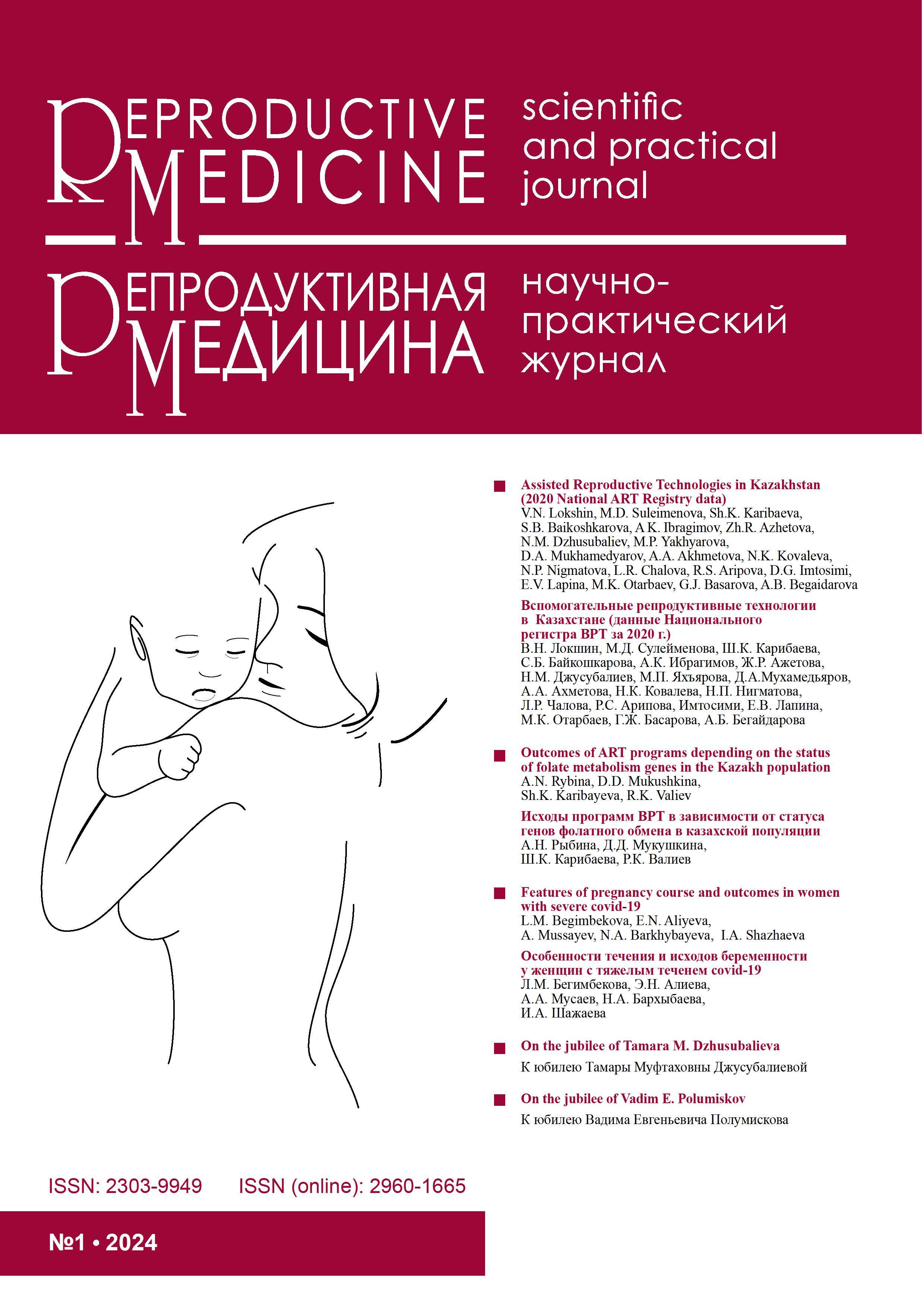Association of obesity with hematological indicators of inflammation in pregnant women
DOI:
https://doi.org/10.37800/RM.1.2024.60-66Keywords:
pregnancy, obesity, inflammation, BMI, anemia, markers of inflammationAbstract
Relevance: Obesity is the abnormal or excessive accumulation of fat that harms health. Many studies have shown that obesity causes an inflammatory response, leading to anemia and other adverse pregnancy outcomes. Our study aimed to examine the association between hematological markers of inflammation and obesity during pregnancy.
The study aimed to evaluate the relationship between hematological markers of inflammation and obesity in pregnant women with anemia.
Materials and Methods: The studies were conducted in the perinatal center at the regional clinical hospital in Karaganda. The clinical study enrolled 92 pregnant women between 2021 and 2022. Clinical data of patients located in the electronic archive of a medical organization was retrospectively analyzed. All examined women were divided into 4 groups: group 1 (n=25) – practically healthy (pregnant women without obesity and anemia); Group 2 (n=22) – pregnant women with anemia without obesity); Group 3 (n=23) – obese pregnant women without anemia; Group 4 (n=22) – pregnant women with obesity and anemia.
Results: A detailed comparative analysis of hematological markers of peripheral blood revealed statistically significant differences (p>0.05) between groups in hemoglobin, erythrocyte sedimentation rate (ESR), lymphocytes, band neutrophils, and eosinophils. According to the Mann- Whitney test, a few hematological parameters, such as red blood cells, platelets, and hematocrit values, were equivalent in the 3 and 4 groups (obese pregnant women). In addition, the level of leukocytes, band neutrophils, lymphocytes, and eosinophils in these groups was higher than in 1 and 2 groups (women without obesity) (p<0.05).
Conclusion: Hematological markers of inflammation (leukocytes, neutrophils, and lymphocytes) were higher in pregnant women with obesity than in groups of healthy pregnant women (without obesity and anemia) and with anemia. It may predict adverse obstetric and neonatal outcomes in pregnant women.
References
Nishtar S, Gluckman P, Armstrong T. Ending childhood obesity: a time for action. Lancet. 2016;387(10021):825-827. https://doi.org/10.1016/S0140-6736(16)00140-9
World Health Organization Europe. WHO European Regional Obesity Report 2022 [Internet]. Updated 2022 May 02; cited 2024 February 09.
https://www.who.int/europe/publications/i/item/9789289057738
Liu K, Chen Y, Tong J. Association of maternal obesity with preterm birth phenotype and mediation effects of gestational diabetes mellitus and preeclampsia: a prospective cohort study. BMC Pregnancy Childbirth. 2022;459.
https://doi.org/10.1186/s12884-022-04780-2
Lewandowska M, Więckowska B, Sajdak S. Pre-Pregnancy Obesity, Excessive Gestational Weight Gain, and the Risk of Pregnancy- Induced Hypertension and Gestational Diabetes Mellitus. J Clin Med. 2020;9:1980.
https://doi.org/10.3390/jcm9061980
Chioma A, Ikedionwu DD, Korede K, Yusuf SI, Abraham A, Salinas-Miranda HM. Pre-pregnancy maternal obesity, macrosomia, and
risk of stillbirth: A population-based study. European Journal of Obstetrics & Gynecology and Reproductive/Biology. 2020;252:1-6.
https://doi.org/10.1016/j.ejogrb.2020.06.004
Vetterlein J, Doehmen CAE, Voss H. Antenatal risk prediction of shoulder dystocia: influence of diabetes and obesity: a multicenter study. Arch Gynecol Obstet. 2021;304:1169–1177.
https://doi.org/10.1007/s00404-021-06041-7
Тайжанова Д., Рустембеккызы Ж., Амирбекова Ж., Комличенко Э., Понамарева О., Жанабаева С. Исходы беременности у жен- щин с предгестационным ожирением. Репрод. мед. 2023;54:109-115.
Tajzhanova D, Rustembekkyzy Zh, Amirbekova Zh, Komlichenko Je, Ponamareva O, Zhanabaeva S. Pregnancy outcomes in women with pregestational obesity. Reproduktivnaja medicina. 2023;54:109-115. (In Russ.)
https://doi.org/10.37800/RM.1.2023.109-115
Madan JC, Davis JM, Craig WY, Collins M, Allan W, Quinn R. Maternal obesity and markers of inflammation in pregnancy. Cytokine. 2009;47:61-64.
https://doi.org/ 10.1016/j.cyto.2009.05.004
Flynn A, Begum S, White S. Relationships between maternal obesity and maternal and neonatal iron status. Nutrients. – 2018. – 10. – P.1000.
https://doi.org/10.3390/nu10081000
Hedengran KK, Nelson D, Andersen MR. Hepcidin levels are low during pregnancy and increase around delivery in women without iron deficiency—a prospective cohort study. J Matern Fetal Neonatal Med. 2016;29:1506-1508. https://doi.org/10.3109/14767058.2015.1052396
Kulik-Rechberger B, Kościesza A, Szponar E. Hepcidin and iron status in pregnant women and full-term newborns in first days of life.
Ginekol Pol. 2016;87:288–292.
https://doi.org/10.17772/gp/62202
Garcia-Valdes L, Campoy C, Hayes H. The impact of maternal obesity on iron status, placental transferrin receptor expression, and hepcidin expression in human pregnancy. Int J Obes. 2015;39:571-578.
https://doi.org/10.1038/ijo.2015.3
Nazif HK, Abd El-Shaheed A, El-Shamy K. Study of serum hepcidin as a potential mediator of the disrupted iron metabolism in obese adolescents. Int J Health Sci. 2015;9:167-174.
https://doi.org/10.12816/0024114
Pihan-Le Bars F, Bonnet F, Loréal O. Iron status Indicators correlate with adiponectin expression in adipose tissue of patients with morbid obesity. Diabetes Metab. 2016;42:105-111.
https://doi.org/10.1016/j.diabet.2015.10.007
Koenig MD, Klikuszowian E, O'Brien KO, Pauls H, Steffen A, DeMartelly V, Ruchob R, Welke L, Hemphill N, LaBomascus B, Pezley L, McLeod A, Hirsch B, Ferrans CE, Tussing-Humphreys L. Prepregnancy Obesity Is Not Associated with Iron Utilization during the Third Trimester. J Nutr. 2020;150(6):1397-1404.
https://doi.org/10.1093/jn/nxaa065
Vilchez G, Lagos M, Kumar K, Argoti P. Is mean platelet volume a better biomarker in pre-eclampsia? J Obstet Gynaecol Res. 2017;43:982-990.
https://doi.org/10.1111/jog.13312
Çintesun E, Çintesun FN, Ezveci H, Akyürek F, Çelik C. Systemic inflammatory response markers in preeclampsia. J Lab Physicians. 2018;10:316-319.
https://doi.org/10.4103/JLP.JLP_144_17
Kamran H, Reza T, Nahid H, Atefe HS, Taghi HS, Azam P. Gestational diabetes mellitus and inflammatory biomarkers of neutrophil-lymphocyte ratio and platelet-lymphocyte ratio: a systematic review and meta-analysis. Biomarkers. 2021;6(26):491-498. https://doi.org/10.1080/1354750X.2021.1926542
Serebryanaya NB, Shanin SN, Fomicheva EE, Yakutseni PP. Blood platelets are activators and regulators of inflammatory and immune reactions, Part 2. Thrombocytes as participants of immune reactions. Medical Immunology (Russia). 2019;1(21):9-20.
Downloads
Published
How to Cite
Issue
Section
License
Copyright (c) 2024 The rights to a manuscript accepted for publication are transferred to the Journal Publisher. When reprinting all or part of the material, the author must refer to the primary publication in this journal.

This work is licensed under a Creative Commons Attribution-NonCommercial-NoDerivatives 4.0 International License.
The articles published in this Journal are licensed under the CC BY-NC-ND 4.0 (Creative Commons Attribution – Non-Commercial – No Derivatives 4.0 International) license, which provides for their non-commercial use only. Under this license, users have the right to copy and distribute the material in copyright but are not permitted to modify or use it for commercial purposes. Full details on the licensing are available at https://creativecommons.org/licenses/by-nc-nd/4.0/.




